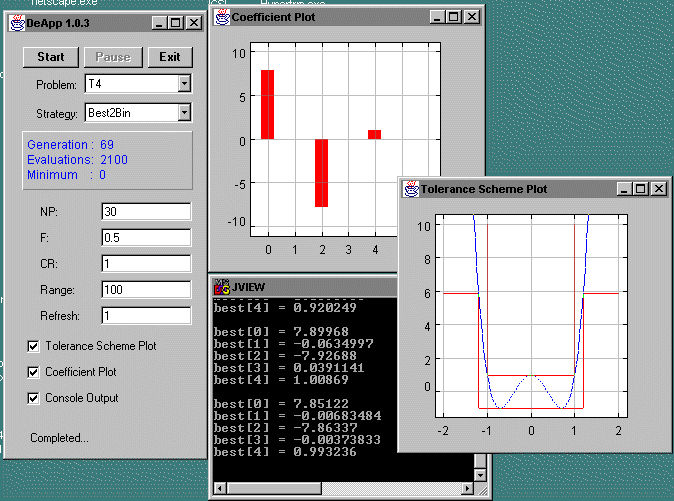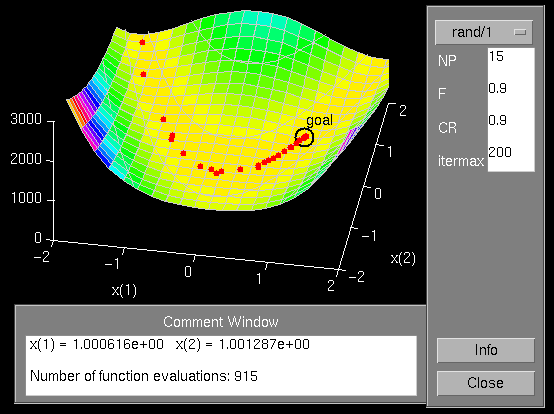Differential Evolution (DE)
for Continuous Function Optimization
(an algorithm by Kenneth Price and Rainer Storn)
Table of contents
Differential Evolution grew out of Ken Price's attempts to solve the
Chebychev Polynomial fitting Problem that had been posed to him by
Rainer Storn. A breakthrough happened, when Ken came up with the idea
of using vector differences for perturbing the vector population.
Since this seminal idea a lively discussion between Ken and Rainer
and endless ruminations and computer simulations on both parts
yielded many substantial improvements which make DE the versatile
and robust tool it is today. The "DE community" has been growing
since the early DE years of 1994 - 1996 and ever more researchers
are working on and with DE. Those scientists who contributed
actively to this homepage are listed at the bottom in alphabetical
order. It is the strong wish of Ken and Rainer that DE will be
developed further by scientists around the world and that DE may
improve to help more users in their daily work. This wish is the
reason why DE has not been patented in any way.
DE is a very simple population based, stochastic function minimizer which is very powerful
at the same time. DE managed to finish 3rd at the
First International
Contest on Evolutionary Computation (1stICEO) which was held in Nagoya,
may 1996. DE turned out to be the best genetic type of algorithm for
solving the real-valued test function suite of the 1st ICEO (the first two
places were given to non-GA type algorithms which are not universally applicable
but solved the test-problems faster than DE). The crucial idea behind DE is a scheme for generating trial parameter vectors. Basically, DE adds the weighted
difference between two population vectors to a third vector. This way no
separate probability distribution has to be used which makes the scheme
completely self-organizing. For further details see the
literature page.
Basically, DE adds the weighted
difference between two population vectors to a third vector. This way no
separate probability distribution has to be used which makes the scheme
completely self-organizing. For further details see the
literature page.
If you are going to
optimize your own objective function with DE, try the following settings
for the input file first: Choose method e.g. DE/rand/1/exp, set the number of parents NP to 10 times the number of parameters, select weighting factor F=0.8
and crossover constant CR=0.9. Make
sure that you initialize your parameter vectors by exploiting their full
numerical range, i.e. if a parameter is allowed to exhibit values in the
range [-100, 100] it's a good idea to pick the initial values from this
range instead of unnecessarily restricting diversity. If you
experience misconvergence you usually have to increase the value for NP, but
often you only have to adjust F to be a little lower or higher than 0.8.
If you increase NP and simultaneously lower F a little, convergence is
more likely to occur but generally takes longer, i.e. DE is getting
more robust (there is always a convergence speed/robustness tradeoff).
DE is much more sensitive to the choice of F than it is to the choice of CR.
CR is more like a fine tuning element. High values of CR like CR=1 give faster
convergence if convergence occurs. Sometimes, however, you have to go down
as much as CR=0 to make DE robust enough for a particular problem. If you
choose binomial crossover like, DE/rand/1/bin, CR is usually higher than
in the exponential crossover variant (in this example DE/rand/1/exp).
Still, F and CR are both generally in the range [0.5, 1.] for most problems
we've encountered. Keep in mind that different problems usually require
different settings for NP, F and CR (have a look into the different papers to get a feeling for the settings). If you still get misconvergence
you might want to try a different method. We mostly use DE/rand/1/... or
DE/best/2/... (for the latter F=0.5 is the standard choice). The crossover method is not so important although Ken
Price claims that binomial is never worse than exponential. In case of misconvergence
also check your choice of objective function. There might be a better one to describe your problem. Any knowledge that you have about the problem
should be worked into the objective function. A good objective function
can make all the difference.
DE is demonstrated here by example of the polynomial fitting problem
(see techreport by Rainer and Ken).
The task is to fit a polynomial
of a certain degree into the tolerance scheme indicated by the
red lines. At x-values +/- 1.2 the polynomial must be higher
than Tk(x) with Tk(x) being the Chebychev Polynomial of degree k.
The constraint at +/- 1.2 can't be seen in the animation as it is fairly
large (~5.9 for T4(x) and ~72.661 for T8(x)). The cost function
to be minimized is the sum of squared errors. Depending on the
DE-variant the T4 problems
takes several thousand function evaluations to be solved. T8
needs about five to ten times as much. The applet was
programmed by
Mikal Keenan (DE) and
Rainer Storn (GUI).
Fetch the source code DEApplet1.java and
DEApplet1.html to see what we have done.
In order to make it easy to do DE optimization on every platform
with the support of graphics a Java application of a DE optimizer
has been written. The current version (1.0.3) runs now both in JDK 1.0.2
as well as JDK 1.1.7. The
code has been enriched with the magnificent
plotting capabilities of ptplot, written by Edward A. Lee and Christopher Hylands
from the University of California, Berkeley. Now it is possible to zoom
in and out of the plots as the optimization is ongoing.
A corrected version of the code
documentation is also available.

To play with DE one only needs the main routine
de36.c (version 3.6), the corresponding header file de.h
along with some example like the polynomial fitting problem (filename e.g. dj9.c)and
the corresponding input file (filename e.g. dj9.dat).
Compile the example by using e.g.
CC de.c dj9.c -o dj9
and run the example by typing
dj9 dj9.dat dj9.out.
Most recently Peter Turney updated the C-code above to make it more compatible
to Visual C++ 6.0 and also to Unix-based C-compilers.
Thanks to Arnold Neumaier and Rainer Storn the DE strategy is also available
in MATLAB code. The vectorized programming, necessary to make MATLAB code reasonably
fast, didn't allow for exponential crossover, so binomial crossover is used
here. The DE strategy is illustrated in
a demo package.  The demo package is intended to let the user
experiment with the different DE-strategies and control variable settings
to obtain experience how DE reacts to the different settings. Currently
a trace of the best population member of each DE-iteration is displayed
as shown in the picture above. A flag-variable in the plot-supporting
function xplt.m allows, however, to show the trace of all population
members simultaneously. The m-files necessary to run the DE-demo in MATLAB
are the demo shell dedemov.m, the actual DE-minimizer devec.m and the plot-supporting function xplt.m.
If you want to use the DE-strategy
in MATLAB for your own purposes it is better to use devec3.m
which minimizes an externally defined objective function, e.g. rosen.m.
Use the help function in MATLAB to obtain the details on how to use devec3.m.
Two helper files, run1.m and run2.m
show you how to work with devec3.m more conveniently.
The demo package is intended to let the user
experiment with the different DE-strategies and control variable settings
to obtain experience how DE reacts to the different settings. Currently
a trace of the best population member of each DE-iteration is displayed
as shown in the picture above. A flag-variable in the plot-supporting
function xplt.m allows, however, to show the trace of all population
members simultaneously. The m-files necessary to run the DE-demo in MATLAB
are the demo shell dedemov.m, the actual DE-minimizer devec.m and the plot-supporting function xplt.m.
If you want to use the DE-strategy
in MATLAB for your own purposes it is better to use devec3.m
which minimizes an externally defined objective function, e.g. rosen.m.
Use the help function in MATLAB to obtain the details on how to use devec3.m.
Two helper files, run1.m and run2.m
show you how to work with devec3.m more conveniently.
There is also a Scilab version of DE written by Walter Di Carlo.
Scilab is a public domain clone of MATLAB
DE is perfectly suited for parallel computation which already has
found an implementation in
PSather,
a parallel object oriented language being developed at
ICSI. The code was developed by
Claudio Fleiner.
You can also get a completely object oriented C++ version of DE by fetching
De37.zip. The code has been developed by Mikal Keenan with
VisualC++ 7.0. Another C++ version, written by Lester Godwin in Visual C++ 5.0,
is available as devcpp.zip.
Another contribution is a
Fortran90 version of DE developed by Prof. Feng-Sheng Wang
and his students.
A recent addition is a
Python version of DE developed by James R. Phillips.
The latest contribution is a
Labview version of DE developed by Franz Josef Ahlers.
If you happen to have access to a DOS-PC and have the graphics driver
egavga.bgi from Borland's C++ library (version 3.1) you have all the
requirements to get two little demo programs running which show DE at work.
These programs are dedemo.exe and
dedemo2.exe (fetch them via SHIFT+"Click" in Netscape)
along with their data files
demo.dat and demo2.dat.
After placing these files in the pertinent directory, all you have to do is type
dedemo demo.dat
which shows you the polynomial fitting problem, or
dedemo2 demo2.dat
which visualizes DE working on Rosenbrock's saddle.
You can even manipulate the .dat files to experiment with different
parameter values. Note however, that the demo programs are not crash proof, i.e.
if you exceed certain limits for the parameters the programs will crash.
So it's best to change e.g. only the number of parents NP < 200, weighting
constant F ex [0,1] and crossing over factor CR ex [0,1] but NOT to change
the number of parameters D. All the other parameters might be safely changed
if the parameters are > 0. But remember: "everything that is free comes
with no guarantee".
A selection of scientific or commercial applications of DE which are accessible
by a URL are listed below.
1)
Digital Filter Design.
2)
Earthquake relocation.
3)
Fusion of information from multiple sensors.
4)
Economic optimal growth modeling.
5)
Multiprocessor synthesis.
6)
Inverse fractal problem solving.
7)
Neural network learning.
8)
Diffraction grating design.
9)
Chrystallographic characterization.
10)
Learning Game Playing Strategies.
11)
Neural Spatial Interaction Modeling.
12)
Beam weight optimization in radiotherapy.
13)
Heat transfer parameter estimation in a trickle bed reactor.
14)
Aerodynamic design.
15)
Electricity market simulation.
16)
Concrete beam reinforcement.
17)
Model optimization for visual rendering tasks.
18)
Optimal Design of Shell-and-Tube Heat Exchangers.
19)
Optimization of an Alkylation Reaction.
20)
Optimization of Thermal Cracker Operation.
21)
Scenario-Integrated Optimization of Dynamic Systems.
22)
Built in optimizer in MATHEMATICA's function Nminimize (version 4.2).
22)
MATLAB's GA toolbox contains a variant of DE.
23)
Optimum planning of cropping patterns.
Louni Lampinen's
DE-bibliography.
The Differential Evolution Society.
 The book "New Ideas in Optimization" by McGraw-Hill contains
a large section about the latest research in Differential Evolution. It is demonstrated that
DE is not only a powerful function optimizer but can also be used for mixed integer
programming and game strategy optimization. Other topics are
Ant Colony Optimization, Immune System Methods, Memetic Algorithms, Particle Swarms
(which is similiar to Differential Evolution), and others. The book can be directly
obtained via
The book "New Ideas in Optimization" by McGraw-Hill contains
a large section about the latest research in Differential Evolution. It is demonstrated that
DE is not only a powerful function optimizer but can also be used for mixed integer
programming and game strategy optimization. Other topics are
Ant Colony Optimization, Immune System Methods, Memetic Algorithms, Particle Swarms
(which is similiar to Differential Evolution), and others. The book can be directly
obtained via
 .
.
 Another book - "New Optimization Techniques in Engineering" - has been published by Springer in 2004 and contains more information about
the recent developments of Differential Evolution. The book is available through
Another book - "New Optimization Techniques in Engineering" - has been published by Springer in 2004 and contains more information about
the recent developments of Differential Evolution. The book is available through


Coming in january 2005
 The book "Differential Evolution - A Practical Approach to Global
Optimization" by Ken Price, Rainer Storn, and Jouni Lampinen (Springer,
ISBN: 3-540-20950-6) will give you the latest knowledge about DE research and computer code
on the accompanying CD (C, C++, Matlab, Mathematica, Java, Fortran90, Scilab, Labview).
The book "Differential Evolution - A Practical Approach to Global
Optimization" by Ken Price, Rainer Storn, and Jouni Lampinen (Springer,
ISBN: 3-540-20950-6) will give you the latest knowledge about DE research and computer code
on the accompanying CD (C, C++, Matlab, Mathematica, Java, Fortran90, Scilab, Labview).
Franz Josef Ahlers,
Walter Di Carlo,
Claudio Fleiner,
Lester Godwin,
Mick (Mikal Keenan),
Rituraj Deb Nath,
Arnold Neumaier,
James R. Phillips,
Kenneth Price,
Rainer Storn ,
Peter Turney,
Feng-Sheng Wang,
Jim Van Zandt
.
 Rainer Storn's Home Page
Rainer Storn's Home Page
 Basically, DE adds the weighted
difference between two population vectors to a third vector. This way no
separate probability distribution has to be used which makes the scheme
completely self-organizing. For further details see the
literature page.
Basically, DE adds the weighted
difference between two population vectors to a third vector. This way no
separate probability distribution has to be used which makes the scheme
completely self-organizing. For further details see the
literature page.

 The demo package is intended to let the user
experiment with the different DE-strategies and control variable settings
to obtain experience how DE reacts to the different settings. Currently
a trace of the best population member of each DE-iteration is displayed
as shown in the picture above. A flag-variable in the plot-supporting
function xplt.m allows, however, to show the trace of all population
members simultaneously. The m-files necessary to run the DE-demo in MATLAB
are the demo shell
The demo package is intended to let the user
experiment with the different DE-strategies and control variable settings
to obtain experience how DE reacts to the different settings. Currently
a trace of the best population member of each DE-iteration is displayed
as shown in the picture above. A flag-variable in the plot-supporting
function xplt.m allows, however, to show the trace of all population
members simultaneously. The m-files necessary to run the DE-demo in MATLAB
are the demo shell 




 The book "Differential Evolution - A Practical Approach to Global
Optimization" by Ken Price, Rainer Storn, and Jouni Lampinen (Springer,
ISBN: 3-540-20950-6) will give you the latest knowledge about DE research and computer code
on the accompanying CD (C, C++, Matlab, Mathematica, Java, Fortran90, Scilab, Labview).
The book "Differential Evolution - A Practical Approach to Global
Optimization" by Ken Price, Rainer Storn, and Jouni Lampinen (Springer,
ISBN: 3-540-20950-6) will give you the latest knowledge about DE research and computer code
on the accompanying CD (C, C++, Matlab, Mathematica, Java, Fortran90, Scilab, Labview).
 Rainer Storn's Home Page
Rainer Storn's Home Page